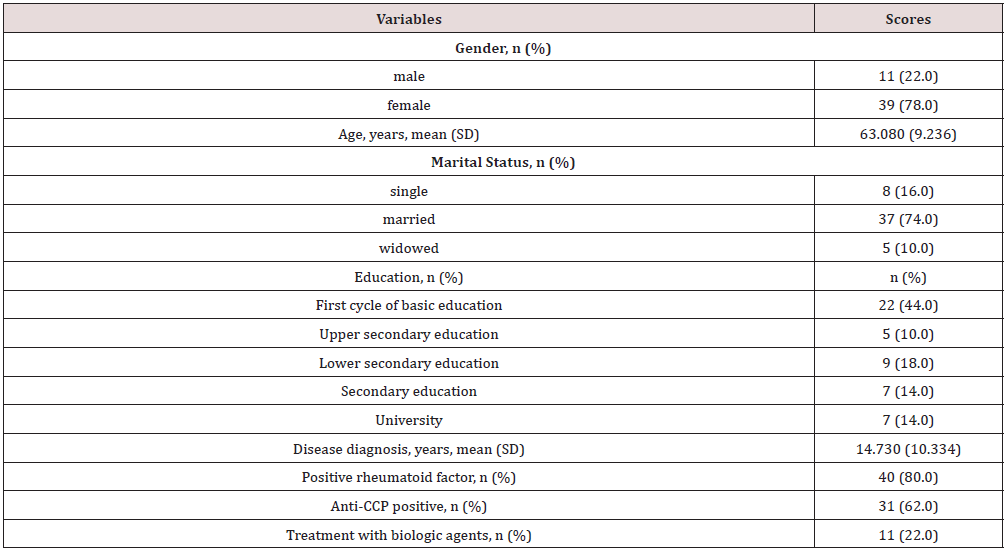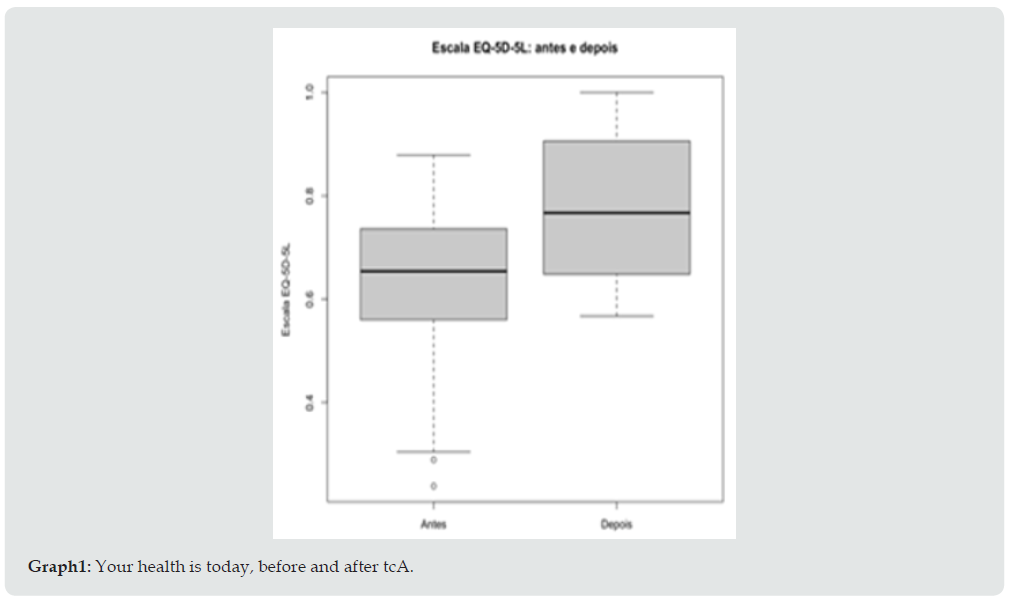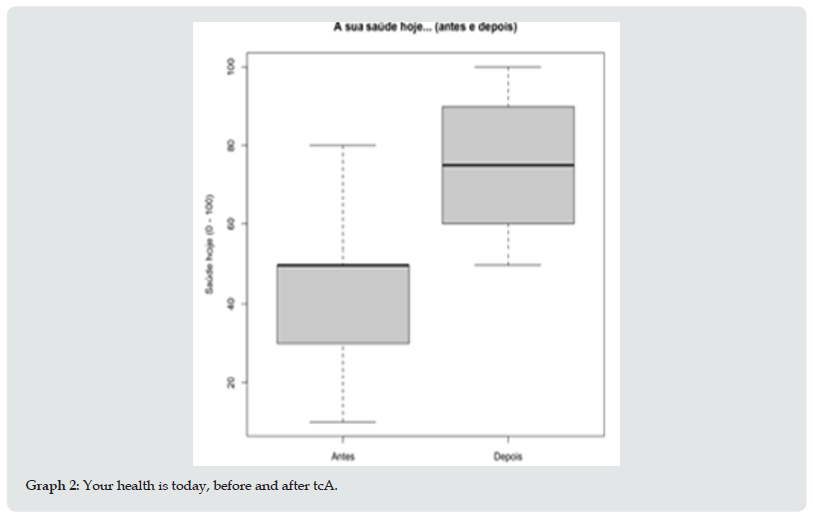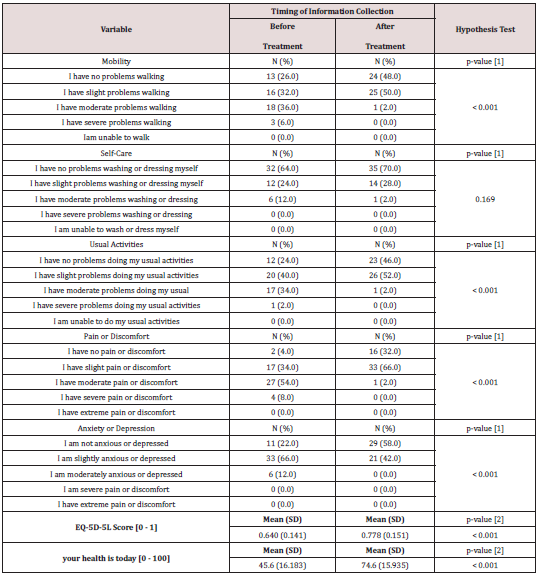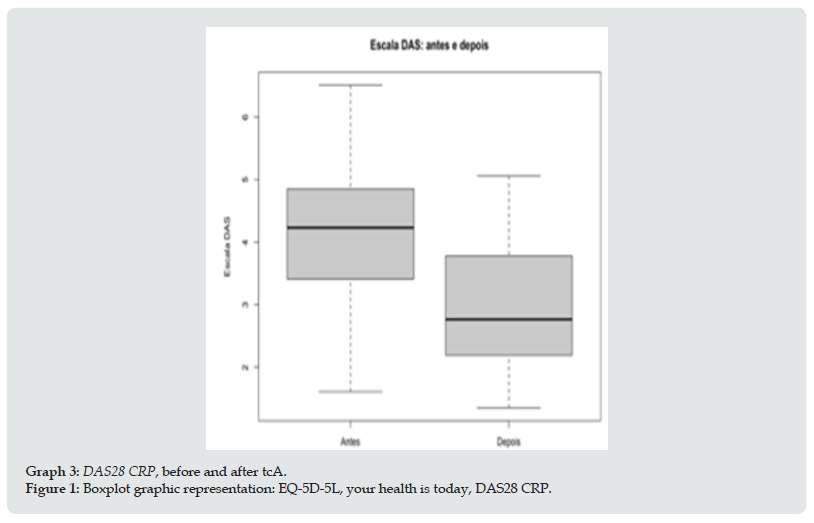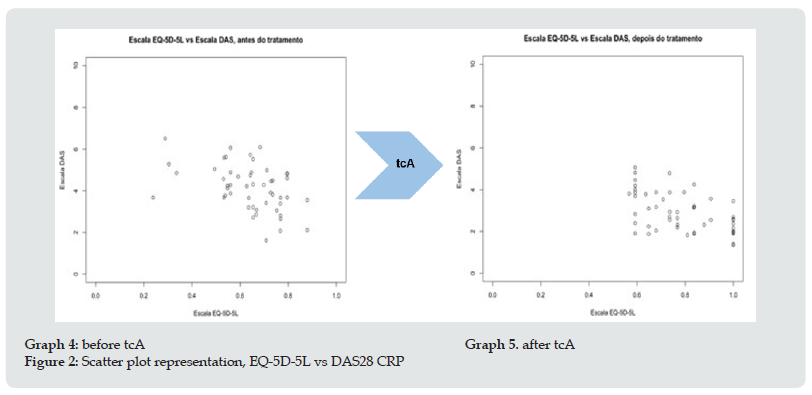
Lupine Publishers Group
Lupine Publishers
Menu
ISSN: 2644-1217
Research ArticleOpen Access
Acupuncture in the Quality of Life of Rheumatoid Arthritis Volume 4 - Issue 1
Diana Seixas1*, Fátima Farinha2, Marcos Pacheco da Fonte3, Manuel Laranjeira4 and Marília Rua5
1University of Porto, Portugal
2Director Clinical Immunology Unit, Centro Hospitalar Universitário do Porto
3Anesthesiologist, Centro Hospitalar Entre o Douro e Vouga, Portugal
4University of Porto, ICBAS, Portugal
5Research Center on Didactics and Technology in Training Trainers, Aveiro University, Portugal
Received: May 05, 2022 Published: May 16, 2022
*Corresponding author: Diana Seixas, University of Porto, Portugal
DOI: 10.32474/OAJCAM.2022.04.000176
Abstract
Objectives: Health and quality of life (QoL) go hand in hand in the path taken daily by multidisciplinary teams, in health promotion and disease prevention, in search of the patient’s overall satisfaction. This study evaluates the effect of acupuncture on the QoL of patients with Rheumatoid Arthritis (RA).
Methodology: Analytical, cross-sectional observational study, analysed 50 patients outlining 3 hypotheses to observe interactions: H1, acupuncture has a mediating effect on QoL assessment; H2, disease activity score (DAS28 CRP) is influenced by acupuncture and H3, QoL and RA disease activity are related
Results: QoL is favorably influenced by acupuncture, with a mean value after complementary acupuncture treatment (tcA) higher than at baseline, assuming a significance level of 0.05. Acupuncture is also a positive mediator in reducing disease activity, achieving 44% of patients in remission and no patients with high disease activity after treatment. It was observed that there is a slight constructive trend in the relationship between QoL and disease intensity, in patients under tcA
Conclusion: The treatment of RA with optimization of QoL and reduction of disease intensity is the most clinically aspired goal, which requires disease management and the offer of therapeutic suggestions able to reach the targets more effectively and efficiently. Acupuncture seems to play an important role when complemented to the already established therapeutic attitudes, in order to achieve the objectives
Keywords: Rheumatoid arthritis; acupuncture; quality of life
Abstract
Introduction
Rheumatoid Arthritis (RA) is a chronic, systemic, autoimmune inflammatory disease which involves the joints symmetrically and may present in a variable extra-articular form (55,57). As a progressive disease, it is associated with severe morbidity, impairment with functional loss, permanent disability and increased mortality, with rapid disease progression in the early stages. Numerous studies indicate that persistent systemic inflammation and immune dysfunction play an important role in the development of comorbidities, such as cardiovascular disease, osteoporosis, interstitial lung disease and malignant pathologies. Without adequate treatment, RA patients develop joint deformity and progressive joint impairment, which takes a toll on health-related quality of life and life expectancy, translating into a high socioeconomic impact with annual costs of more than $56 billion, in the United States (5,9,16,31).
Currently, the drugs used to treat RA are: glucocorticoids (GCs) and non-steroidal anti- inflammatory drugs (NSAIDs), used predominantly to control pain and inflammation; disease-modifying antirheumatic drugs (DMARDs), administered as first-line drugs for newly diagnosed cases of RA; and biologic therapies, used to target and inhibit specific molecules of the immune and inflammatory responses. New treatment strategies have significantly altered the behavior of RA. Disease remission can be achieved by early disease diagnosis with prompt and continued treatment, however, the gap in RA treatment remains, as some patients do not develop sufficient response to currently available agents, remission is not always achieved and refractory disease is also not uncommon. Rapid diagnosis and a treat-to-target approach, with close monitoring and control, increase the likelihood of disease remission. Treatment of RA is known to be hampered by late diagnosis, problematic access to specialists and difficulty in adhering to the outlined “treat-to-target” principles. The goals of research and clinical trials in RA are to allow rapid access to optimal diagnosis and treatment and the appropriate, targeted use of the various approved treatments for this disease (29,30,31).
High-quality scientific evidence on the pharmacological and non-pharmacological treatment of difficult-to-treat RA patients is scarce. A 2021 systematic review of the literature shows a beneficial effect of non-pharmacological interventions (exercise, psychological, educational and self-management) which were responsible for improving noninflammatory complaints (mainly functional impairment, pain and fatigue), goal setting and self-care in RA patients (32). TCM is a systematic health method, developed thousands of years ago from clinical experience and based on a scientific model of regulation. It adopts external and internal treatments, taking as its principle the cause of the disease, the differentiation of the syndrome and the clinical symptomatology of the patients. Acupuncture has been studied since the 1980s by the WHO, which recognized it as a therapy with beneficial effects in various pathologies. In order to promote international collaboration in scientific research it developed the “WHO Traditional Medicine Strategy 2014-2023”. It recently published “WHO benchmarks for the training of acupuncture” in order to create mandatory norms and standards for its practice, after 88% of WHO Member States recognized in 2018 the use of traditional and complementary medicine (60). Acupuncture is one of the most popular and widely used techniques in TCM. It is based on the meridian theory, stimulating specific acupuncture points with needles in order to restore the body’s internal balance (1,6,15). Through stimulation of the central and peripheral nervous system, acupuncture causes biochemical changes that influence the body’s homeostatic mechanisms, reducing sensitivity to pain, stress and inflammation. Acupuncture promotes the release of vascular and immunomodulatory factors that improve biomechanical functions, as well as stimulating the nervous system for the secretion of endorphins and other neuronal factors responsible for processing pain in the brain and spinal cord and increasing local microcirculation (4,25,26). Although the therapeutic approach and the Eastern and Western anatomopathology are considerably different, acupuncture emerges as a complementary therapy, showing good results in reducing pain and rehabilitating motor skills, improving functionality and quality of life, either individually or in conjunction with other procedures (21). The pharmacological, surgical or rehabilitation treatments usually used in Western Medicine, reported as successful, often do not produce satisfactory therapeutic effects and may cause undesirable side effects (1,21). Thus, acupuncture has long been recognized by the World Health Organization (WHO) for its mechanism of action, with analgesic and antiinflammatory effects is now accepted by the medical community, and is considered to present superior results to placebo, despite the great debate in the scientific community regarding the mechanisms of action and therapeutic methodology (22). A guideline developed in the United Kingdom in 2021 by the National Institute for Health and Care Excellence (NICE) in collaboration with the Royal College of Physicians (RCP) considers acupuncture one of the non-pharmacological options to improve treatment experience and outcomes in patients with chronic pain, recognizing the benefit of its effect when compared to a placebo effect (42). The integration of TCM into Western health care systems therefore requires a science-based approach supported by controlled research, overcoming and clarifying limitations, controversies, and paradigms (6,23,24).
This study is based on the Heidelberg Model of TCM [1], which explains mathematically the regulation of a system through a sinus wave, which reflects regulatory states of the body, or ascending and descending energies, which proceed circular processes and include antagonistic parts of the movement (compass rose). Thus, the regions of the body, are predominantly stimulated in a particular internal movement occurring an automatic activation which starts in the liver region, followed by the chest and heart center and finally, progresses through the hypochondrium and lungs to the lower abdomen and kidneys (4,27,28). In classical TCM, part of RA disease is believed to result from an invasion of external pathogenic elements (wind, cold, heat and humidity) in conjunction with reactive heat striking the Yin and with a pattern of deficiency of Qi and Xue and of Yin and Yang of the liver and kidneys. In the general TCM classification RA is classified as “Bi” or occlusion syndrome, characterized by poor circulation of Qi and Xue (stasis) and affected by agents that block the flow of energy in the meridians, affecting muscles and bones (4,35-40).
In the last 20 years the approach to RA treatment has evolved significantly. As it is a heterogeneous disease, treating a patient with RA with the right drug at the right time is one of the main challenges faced. Moreover, long-term use of currently available therapy is often accompanied by unwanted side effects. About 20-40% of RA patients do not clinically benefit from this therapy, stimulating the search for new therapeutic targets with improved efficacy (34). Acupuncture has been prescribed for pain relief caused by inflammation in affected joints, although the most notable current data suggest that it reduces pain because it is a particularly powerful placebo and can be safely administered in conjunction with conservative treatment (33). In Portugal, there is no therapeutic protocol/ plan in acupuncture. The lack of clarity and/or exposure of effective results has hindered the implementation of acupuncture either as an isolated treatment or in conjunction with other therapy already implemented [2-5]. It is still not clear what type of patient (patients without a therapeutic regimen and/or patients refractory to pharmacological treatment) and at what stage of disease severity it should be proposed, reducing the possibility of adopting acupuncture as a continuous treatment. As far as is known from the various studies conducted, these two patterns have not been precisely identified, as well as inclusion criteria based on indices of disease severity and non- response to pharmacological therapy have not been clearly defined. In these studies, inclusion criteria have been mainly based on the visual analogue scale (VAS) of pain, non-improvement with baseline pharmacological therapy and even specific inclusion criteria based on unspecified disease-related indicators (41).
Thus, it is increasingly common in research and clinical practice to assess quality of life (QoL) in RA. QoL is related to the ability to do things/activities. RA has numerous impacting consequences on patients’ QoL, covering both physical and mental domains and well-being, related to daily pain, physical disability, personal, social and economic resources. QoL is more focused on physical functioning and negative mental aspects, such as depressed mood and anxiety (43-45). QoL assessment is particularly useful for several reasons. First, many patients value it more than disease-related variables (inflammatory biomarkers or joint count), and assessing clinical status only in terms of restricted disease activity may not characterize the patients’ primary health status and concern. Second, reduced QoL in RA patients is associated with increased use of health resources and increased depressive states. It is therefore essential to limit the factors that influence QoL (3,16). The inclusion of patient-reported outcomes, which provide the patient’s perspective on the disease in clinical practice and research, is supported by international organizations and professional groups. Many studies have shown that patient-reported feedback on the control of inflammation by immunosuppressive therapy is positive. Thus, there is no doubt that controlling the disease process is as important for preventing long-term side-effects as it is for improving patients’ QoL, since there is still a considerable number of RA patients who are in remission who report a high impact of the disease on reducing QoL (45).
This study reflects the feedback from patients with RA who underwent acupuncture treatment to complement the existing therapy, regarding their QoL. Based on previous literature[6-10], the study was designed to address the following hypotheses:
a. H1: acupuncture has a mediating effect on QoL assessment
b. H2: the DAS28 CRP is influenced by acupuncture
c. H3: QoL and RA disease activity are related
Methods
Participants and Study Design
An analytical, cross-sectional observational study, carried out at two assessment times, with an 8-week interval between each assessment, aimed to assess the QoL of patients with RA who are subjected to a complementary therapy plan with acupuncture (tcA) [10-15]. The study includes adult patients with RA diagnosed according to the American College of Rheumatology / European League Against Rheumatism (ACR/EULAR) criteria (46), undergoing treatment complementary to existing acupuncture therapy, attending the consultation of Autoimmune Diseases in the Clinical Immunology Unit (UIC) of the University Hospital Centre of Porto - Santo António Hospital (CHUP - HSA). All patients who agreed to participate in the study had the ability to read and interpret the applied questionnaires. Written informed consent was signed prior to the study. Ethical approval was granted by the Department of Education, Training and Research: Hospital de Santo António (2019.143(114-DEFI/118-CE)[15-20].
Instruments
Health-related QoL was assessed by the EQ-5D-5L questionnaire, validated by the EuroQoL Group (48). It includes five dimensions (mobility, personal care, usual activities, pain/discomfort and anxiety/depression). Each dimension consists of 5 levels: no problems, mild problems, moderate problems, severe problems and unable [21]. The combination of the five scores leads to a score index between: 0.59 and 1.00 (49). Higher scores indicate better QOL. The EQ-5D-5L also allows the participant to provide (by comparing with their general level of health in the last 12 months) a perception of their current health status. They are asked to choose/identify on the visual analogue scale (VAS-QoL) a value from 0 to 100, considering 0, the worst imaginable state of health and 100, the best imaginable state of health. However, it should be highlighted that the VAS- QS, despite being a simple process to attribute value, does not allow representing the compromise between quantity and quality of life and, for that reason, does not provide cardinal values or usefulness and cannot contribute to the determination of QoL (48). Disease activity was assessed by the Disease Activity Score 28, DAS28 CRP, through the respective variables: joints with oedema and joints with pain; C-reactive protein (CRP) and patient’s global health status (52).
Clinical And Epidemiological Analysis
The sample was characterized through a survey of socio-demographic variables: gender; age; marital status and academic qualifications. Information regarding the date of diagnosis of the disease (in years) was also collected for each patient[22-25].
Abstract
Data Analysis
The notation used in the study is the most usual in scientific and academic terms, namely in research articles in the area and in Applied Statistics courses[26-29]. As regards the programming language, the RStudio software, version 1. 4. 1103, was used for this study. The software has an associated error of 1.110223 x 10-16. To obtain the statistics, the following functions were considered: (i) table(), for absolute and relative frequencies as the categorical variables; (ii) summary(), to obtain the statistics in the case of continuous variables. Concerning the hypothesis tests and taking into account the comparison of the values of the variables relative to the same sample, at two different moments in time, we chose the functions: t.test(), to compare the means of the continuous variables and the StuartMaxwellTest() for the comparison of the proportions in the categorical variables. The Stuart-Maxwell test was chosen over others, to the extent that each categorical variable presents five distinct groups, which makes other tests more frequently used in binary categorical variables unfeasible. The graphical representations of the boxplots were obtained considering the boxplot() function. For the application of hypothesis tests, a significance level (α = 0.05) was considered, with the null hypothesis being the equality of responses before and after tcA.
Results
Sample characteristics
The study sample consists of 50 individuals, whose sociodemographic and clinical characteristics are shown in Table 1. The participants are mostly (78%) female. Age ranged from 36 to 80 years, with a mean age of 63 years and a standard deviation of 9.236. Regarding academic qualifications, 44% of the individuals had completed the first cycle of education and only 14% had attended higher education. The majority, 37 patients (74%) are married. The average time of diagnosis with RA was over 14.7 years (SD10,334), with 80% of patients having positive rheumatoid factor and 62% of the sample having positive analytical values for anti-cyclic citrullinated peptide antibody (anti-CCP). Regarding the therapy already instituted, 11 patients (22%) are under treatment with biological agents.
EQ-5D-5L and DAS28 CRP Scale
The representation of the statistical analysis of the evaluation of the EQ-5D-5L scale and DAS28 CRP is based on the data presented in Table 2, Graph 1 and Graph 2 below. From the interpretation of Table 2, it can be seen that before the tcA, 68% of the individuals claimed to have slight or moderate problems in walking. After the treatment, 98% mentioned that they had slight or no problems. With regard to personal care, there is a slight increase (32 - 35 individuals) between before and after tcA - 3 more individuals say that they have no difficulties in washing and dressing. Before the tcA 24% of the individuals said they had no problems performing their usual activities. This number almost doubles (46%) after treatment. There is an increase of 60%, between before and after treatment, for the number of individuals who do not feel any pain/ discomfort, or it is slight. Likewise, there is a marked reduction in the number of individuals who felt some type of anxiety and/or depression.
The hypothesis tests applied with the purpose of assessing whether the individuals’ answers to the various items were similar before and after the tcA lead us to conclude that, assuming a 0.05 significance level, for the variables: mobility; usual activities; pain/ discomfort and anxiety/depression, there are significant differences. Only for the variable personal care, we cannot assume the existence of differences between before and after the tcA. Thus, since the EQ-5D-5L scale score is dependent on the numerous variables mentioned above, the increase in its mean value was to be expected. The score before treatment was 0.640, increasing to 0.778 af ter treatment. Applying a Student’s t-test to evaluate the equality of means, before and after tcA, we may conclude that they are different, assuming a significance level of 0.05. This is corroborated by the boxplots, presented in graph 1 and graph 2, which clearly show the improvement in the EQ-5D-5L score after treatment. As regards the question “Your health today”, through the hypotheses test applied, with a maximum significance level of 0.05, we rejected the null hypothesis that the two means are similar, accepting the alternative hypothesis that there are differences between the means before and after the tcA. Initially, before undergoing tcA, individuals mentioned having a perception of their current health status (SD 45.6), lower than the mean value of the EQ-EVA available for completion in the scale, differing from the mean value after TCA (SD 74.6). By observing the boxplot corresponding to graph 2, we found that most individuals showed values of perception of their current health after TCA that were much higher than the values that reflected the perception of the current health of individuals prior to TCA. Graph 3 shows the analysis of the DAS28 CRP - its mean value before tcA was 4.13, with 6% of patients in RA remission, 12% with low disease activity, 68% with moderate disease activity and 14% of patients with high RA activity. The mean DAS28 CRP value after tcA was 2.95, and the percentage of individuals in disease remission increased considerably, reaching 44% and with low RA activity 22%. The number of patients with moderate disease activity decreased to half (34-17) after tcA, which corresponds to 34% of the study sample, and there were no patients with high RA activity, according to this DAS28 CRP score/index (Figure 1).
Representations of the EQ-5D-5L scale vs. DAS28 CRP
The relationship between the EQ-5D-5L scale and the DAS28 CRP was made by means of dispersion graphs, represented below - graph 4 and graph 5. It can thus be observed that they present the same dimensions in the axes, so that they can be directly compared. Both seem to suggest that the higher the EQ-5D-5L scale value, the lower the DAS28 CRP value. Comparing before tcA with after tcA and as it was already possible to conclude from the observation of the boxplot, there is a dispersion shift towards the lower right corner of the graph, revealing that after tcA the DAS28 CRP values decrease and the EQ-5D-5L scale values increase. It is considered here that these conclusions could be different if the sample size were significantly larger, as it would increase the perception of the trend of the data (Figure 2).
Discussion
The present study concisely and comprehensively reveals the impact of acupuncture on the quality of life of patients with RA, followed in an outpatient clinic and under complementary treatment to the already ongoing, “usual” pharmacological treatment with acupuncture.
The study illustrates the relationship between acupuncture and RA activity, QoL itself, and the correlation between QoL and disease activity, before and after tcA. Overall, the results showed that acupuncture has a positive mediating effect on both disease activity and QoL of RA patients, as well as on each patient’s current health perception. The individual assessment of each variable under study or together, crossing results and perceiving relationships is evident and positive, whenever the effects described by each patient are observed. This fact entails important clinical implications. First of all, QoL is nowadays recognized as an important variable in the study of patients, regardless of their pathology (54), and it is also recognized that the outcomes reported by RA patients provide important information on the effect of the disease (53).
Looking at QoL as a key element and a goal to be achieved by both the patient and the medical team, and knowing that RA significantly impairs QoL in the population (20), as well as that acupuncture reduces pain and improves quality of life (42), the increase in the mean value of the EQ-5D-5L scale of about 14% before and after tcA, highlights the beneficial effect of this therapy on patients’ QoL, responding to H1. initially outlined. Similarly, the assessment of “their health today” is revealing of the influence of the complementary therapy under study, as the mean value increases significantly after tcA. With regard to H2. of the study, the DAS28 CRP shows very favorable values, demonstrating that tcA considerably reduced the RA disease activity, reaching 44% of patients in remission and no patient with high disease activity after tcA. In view of the relationship between QoL and RA disease activity, posed in H3., it can be seen that acupuncture created a favorable trend, as the DAS28 CRP decreased as the EQ-5D-5L scale score increased, corroborating “lower scores on the EQ-5D-5L scale are associated with severe disease activity” (56). The present study therefore does not notably differentiate patients’ QoL by RA severity.
The results presented should be interpreted taking into account some limitations. We highlight the sample size which, although small, allowed a clear and consistent response to the hypotheses initially put forward. However, in order to increase the number of patients and, consequently, the individual characteristics and diversity of answers, it is important to research the topic under study with a larger number of individuals. Another limitation relates to the type of study, since an analytical, cross-sectional observational study does not allow testing cause-effect relationships according to the intervention (acupuncture), which makes a randomized experimental study indispensable for a better assessment of the hypotheses raised. We also point out the time period of data collection, which took place over 11 months and therefore the seasonality of rheumatological inflammatory complaints was not taken into account, despite its potential confounding effect. We also mention the subjectivity of some of the assessed questions, such as the perception of the individual health status of each patient, which may be a confounding element. Finally, we mention the fact that patients’ perception and feedback may be influenced by factors such as professional and marital situation, loneliness, material wealth and social status.
Key Messages
From the literature review described above, in line with the results presented, we found that RA influences the QoL of patients. Patient feedback acquired by filling in indices and scales is a valuable tool to clarify and demystify the real effects of complementary acupuncture treatment. The intensity of RA disease is favorably mediated by acupuncture, and it is believed that there is a direct relationship between the phase of disease activity and the quality of life manifested by patients.
Overall, it is perceived that acupuncture, when integrated into existing therapy, has a beneficial effect on the quality of life of patients with RA. The effect of complementary medicine associated to the therapeutic plans practiced in Western medicine is positive, however, it is emphasized the importance of scientific research with a greater number of studies, capable of supporting the hypotheses raised here. It is believed that the clinical evidence of the therapeutic results achieved through acupuncture is a precursor to the implementation of this technique in daily clinical activity, promoting health and preventing disease, with a higher quality of life for patients. This study adds to the analysis of the effects of acupuncture, and is a contribution to the demonstration of its effectiveness and quality as a therapy, in order to increase safety and confidence in its practice. Assuming that controlling the impact of RA, in terms of quality of life, is one of the ultimate goals in the management of the disease, the integration of acupuncture in clinical practice should be considered, as one of the means to achieve this goal, increasing the field of existing interventions for the treatment of RA, in order to achieve excellence of care, with better results!
Acknowledgment
We would like to thank all the study participants and their families. To Dr. Fátima Farinha for her tireless dedication, patience and help! To all the members of the multidisciplinary team of HSACHUP and CICA for their collaboration and availability!
Collaborators
Ricardo Santos performed all the analysis and statistical work. Rúben Costa validated linguistics. Jacqueline Ferreira and Jorge Silva managed the space and consultation schedules. Ana Tavares collected the patient list and facilitated the telephone contact.
Financing
No specific funding was received for the work described in this article, either from public, commercial or non-profit entities.
Ethical Approval
Granted by the Department of Education, Training and Research: St Anthony’s Hospital (2019.143(114-DEFI/118-CE).
References
- Martinec R, Pinjatela R, Balen D (2019) Quality of life in patients with rheumatoid arthritis - a preliminary study. Acta Clin Croat 58(1): 157-166.
- Wu CY, Yang HY, Luo SF (2021) From Rheumatoid Factor to Anti-Citrullinated Protein Antibodies and Anti- Carbamylated Protein Antibodies for Diagnosis and Prognosis Prediction in Patients with Rheumatoid Arthritis. Int J Mol Sci 22(2).
- Seca S, Patrício M, Kirch S, Giovanna Franconi , António S Cabrita, et al. (2019) Effectiveness of Acupuncture on Pain, Functional Disability, and Quality of Life in Rheumatoid Arthritis of the Hand: Results of a Double-Blind Randomized Clinical Trial. J Altern Complement Med 25(1): 86-97.
- Cheung TT, McInnes IB (2017) Future therapeutic targets in rheumatoid arthritis? Semin Immunopathol 39(4): 487-500.
- Roodenrijs NMT, Hamar A, Kedves M, Désirée van der Heijde , Paco M J Welsing, et al. (2021) Pharmacological and non-pharmacological therapeutic strategies in difficult-to-treat rheumatoid arthritis: a systematic literature review informing the EULAR recommendations for the management of difficult-to-treat rheumatoid arthritis. RMD Open 7(1).
- Patel M, Urits I, Kaye AD (2020) The role of acupuncture in the treatment of chronic pain. Best Pract Res Clin Anaesthesiol 34(3): 603-616.
- Matos LC, Machado JP, Monteiro FJ (2021) Understanding Traditional Chinese Medicine Therapeutics: An Overview of the Basics and Clinical Applications. Healthcare (Basel) 9(3).
- Pu MJ, Yao CJ, Liu LM (2021) Traditional Chinese medicine for gouty arthritis: A protocol for meta-analysis. Medicine (Baltimore) 100(3): e23699.
- Seca S, Kirch S, Cabrita AS, et al. (2016) Evaluation of the effect of acupuncture on hand pain, functional deficits and health- related quality of life in patients with rheumatoid arthritis--A study protocol for a multicenter, double-blind, randomized clinical trial. J Integr Med 14(3): 219-227.
- Macfarlane GJ, Paudyal P, Doherty M, Julius Sim, Gareth T Jones, et al. (2012) A systematic review of evidence for the effectiveness of practitioner- based complementary and alternative therapies in the management of rheumatic diseases: rheumatoid arthritis. Rheumatology (Oxford) 51(9): 1707-1713.
- Lee WY, Chen HY, Chen KC, et al. (2014) Treatment of rheumatoid arthritis with traditional chinese medicine. Biomed Res Int 2014: 528018.
- Teixeira J, Santos MJ, Matos LC (2018) Evaluation of the Effectiveness of Acupuncture in the Treatment of Knee Osteoarthritis: A Case Study. Medicines (Basel) 5(1): 18.
- Zhou W, Benharash P (2014) Effects and mechanisms of acupuncture based on the principle of meridians. J Acupunct Meridian Stud 7(4): 190-193.
- Cheng KJ (2014) Neurobiological mechanisms of acupuncture for some common illnesses: a clinician's perspective. J Acupunct Meridian Stud 7(3): 105-114.
- George G, Shyni GL, Raghu KG (2020) Current and novel therapeutic targets in the treatment of rheumatoid arthritis. Inflammopharmacology 28(6): 1457-1476.
- Di Carlo M, Beci G, Salaffi F (2020) Acupuncture for Fibromyalgia: An Open-Label Pragmatic Study on Effects on Disease Severity, Neuropathic Pain Features, and Pain Catastrophizing. Evid Based Complement Alternat Med 2020;:9869250.
- Angner E, Ray MN, Saag KG (2009) Health and happiness among older adults: a community-based study. J Health Psychol 14(4): 503-512.
- Diener E, Pressman SD, Hunter J (2017) If, Why, and When Subjective Well-Being Influences Health, and Future Needed Research. Appl Psychol Health Well Being 9(2): 133-167.
- Santos EJF, Duarte C, Ferreira RJO, Ana Margarida Pinto , Rinie Geenen, et al. (2018) Determinants of happiness and quality of life in patients with rheumatoid arthritis: a structural equation modelling approach. Ann Rheum Dis 77(8): 1118-1124.
- Matcham F, Scott IC, Rayner L, Sam Norton , David L Scott , et al. (2014) The impact of rheumatoid arthritis on quality-of-life assessed using the SF-36: a systematic review and meta-analysis. Semin Arthritis Rheum 44(2): 123-130.
- Aletaha D, Neogi T, Silman AJ, Neal S Birnbaum, Gerd R Burmester, et al. (2010) Rheumatoid arthritis classification criteria: an American College of Rheumatology/European League Against Rheumatism collaborative initiative. Arthritis Rheum 62(9): 2569-2581.
- Ferreira PL, Ferreira LN, Pereira LN (2013) Contribution for the validation of the Portuguese version of EQ-5D. Acta Med Port 26(6): 664-675.
- Ferreira LN, Ferreira PL, Pereira LN (2014) EQ-5D Portuguese population norms. Qual Life Res 23(2): 425-430.
- Fransen J, van Riel PL (2009) The Disease Activity Score and the EULAR response criteria. Rheum Dis Clin North Am 35(4): 745-757.
- Haroon N, Aggarwal A, Lawrence A, et al. (2007) Impact of rheumatoid arthritis on quality of life. Mod Rheumatol 17(4): 290-295.
- Levent Kilic , Abdulsamet Erden , Clifton O Bingham, Laure Gossec , Umut Kalyoncu (2016) The Reporting of Patient-reported Outcomes in Studies of Patients with Rheumatoid Arthritis: A Systematic Review of 250 Articles. J Rheumatol 43(7): 1300-1305.
- Haridoss M, Bagepally BS, Natarajan M (2021) Health-related quality of life in rheumatoid arthritis: Systematic review and meta-analysis of EuroQoL (EQ-5D) utility scores from Asia. Int J Rheum Dis 24(3): 314-326.
- Guidance N (2021) Chronic pain (primary and secondary) in over 16s: assessment of all chronic pain and management of chronic primary pain NICE, UK.
- A Kavati HR (2013) Impact Of Rheumatoid Arthritis (Ra) On Quality Of Life (QOL) In A Nationally Representative Population In The United States. Value in Health 16(3): A227-A27.

Top Editors
-

Mark E Smith
Bio chemistry
University of Texas Medical Branch, USA -

Lawrence A Presley
Department of Criminal Justice
Liberty University, USA -

Thomas W Miller
Department of Psychiatry
University of Kentucky, USA -

Gjumrakch Aliev
Department of Medicine
Gally International Biomedical Research & Consulting LLC, USA -

Christopher Bryant
Department of Urbanisation and Agricultural
Montreal university, USA -

Robert William Frare
Oral & Maxillofacial Pathology
New York University, USA -

Rudolph Modesto Navari
Gastroenterology and Hepatology
University of Alabama, UK -

Andrew Hague
Department of Medicine
Universities of Bradford, UK -

George Gregory Buttigieg
Maltese College of Obstetrics and Gynaecology, Europe -

Chen-Hsiung Yeh
Oncology
Circulogene Theranostics, England -
.png)
Emilio Bucio-Carrillo
Radiation Chemistry
National University of Mexico, USA -
.jpg)
Casey J Grenier
Analytical Chemistry
Wentworth Institute of Technology, USA -
Hany Atalah
Minimally Invasive Surgery
Mercer University school of Medicine, USA -

Abu-Hussein Muhamad
Pediatric Dentistry
University of Athens , Greece

The annual scholar awards from Lupine Publishers honor a selected number Read More...




